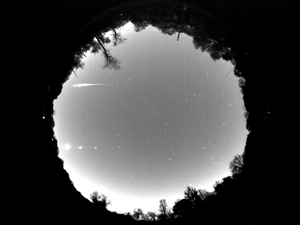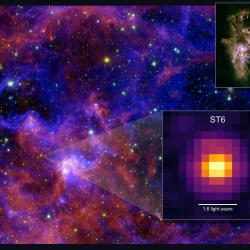UMD Astronomers Install All-sky Cameras on Campus and in Haiti
All-sky cameras can capture stars, meteors, cloud formations and much more
Not all astronomy observatories need to be on remote mountaintops. Using an all-sky camera—with a wide-angle view that can capture a large area of the sky and up to a thousand photos per night automatically—one can install an observatory anywhere in the world.
 Peter Teuben, an associate research scientist in the Department of Astronomy at the University of Maryland, installed such a camera in Haiti.
Peter Teuben, an associate research scientist in the Department of Astronomy at the University of Maryland, installed such a camera in Haiti.
“I have friends and collaborators in Haiti,” Teuben explained. “When I told one of them about all-sky cameras, he invited me to bring one over and use it as a tool to teach his students astronomy, which is not formally taught there.”
Teuben accepted the invitation to the Ecole Supérieure d’Infotronique d’Haïti (ESIH), a higher education institution in Port-au-Prince, Haiti. With funding from the International Astronomical Union Office of Astronomy for Development, he purchased an Oculus all-sky camera and installed the camera at ESIH in 2016.
Using photos taken by the camera, Teuben showed a class of ESIH students how to identify celestial objects, such as planets and constellations. Teuben then taught the same students to program in Python so that they could write code for a Raspberry Pi—a miniature computer—to automatically upload the images from the camera to a database at the UMD Observatory.
Haiti experiences less light pollution than Maryland, according to Teuben, making the island ideal for observing the night sky. However, Haiti’s infrastructure makes observation with an all-sky camera challenging at times.
“Although our setup is fully functional, the electricity goes out a lot in Haiti, meaning the camera can’t always operate,” said Teuben. “We are building a watertight box with a power supply inside so the camera can run at all times.”
To give the ESIH students more astronomy-related opportunities, Teuben helped two of them attend a winter workshop hosted by the Graduate Resources for Advancing Diversity with Maryland Astronomy and Physics (GRAD-MAP) program at UMD. There, the students took programming tutorials, carried out astronomy research and observed on radio telescopes at the Green Bank Observatory in West Virginia.
But Teuben’s not done—he continues to reach out to students in Haiti with the hope of getting them interested in observing the night sky.
“I met another professor based in Haiti, and I’m trying to convince him to install an all-sky camera at his institution and show his students how the stars and planets move,” Teuben said.
Teuben found his inspiration to install all-sky cameras in Haiti from Elizabeth Warner, a principal faculty specialist in the UMD Department of Astronomy and director of the UMD Observatory.
In spring 2015, Warner proposed installing several all-sky cameras in Maryland to create an all-sky camera network. To raise money to buy the hardware, Warner led a crowdfunding campaign through Launch UMD. The campaign raised enough money to purchase five cameras.
That summer, Warner installed an Oculus all-sky camera at the UMD Observatory. The camera has collected almost a terabyte of images and captured stars, airplanes, helicopters and the International Space Station. It has also spotted meteors.
“We have gotten calls from the NASA Meteoroid Environment Office, or the ‘fireball’ office, and we’ve been able to confirm a few meteor sightings for them,” Warner said. “In the future, we’d like to use multiple cameras to improve meteor tracking.”
Warner also plans to make the photo collection available for other interested researchers.
“Meteorologists are interested in information such as how many clear versus cloudy nights we have here in Maryland, what times of the night the sky is clear and what kinds of cloud formations we have,” Warner said. “We can create these records with our data.”
Although Warner has four more all-sky cameras that she plans to install at off-campus locations, controlling the cameras remotely presented a challenge.
“Out of the box, the camera is not set up to be operated remotely,” Warner explained. “We have had to write our own code pipeline to make remote operation possible, which a number of undergraduate students have been working on.”
Joseph Cohen, an aerospace engineering major, is one of those students. His software automatically uploads photos from the camera to the Observatory database and then finds photos containing meteors. Cohen also wants to automatically upload photos of detected meteors to the Observatory’s webpage.
“I’m in the Science, Discovery and the Universe College Park Scholars program and working on the all-sky camera is my capstone project,” said Cohen, who is jointly advised by Teuben and Warner. “The part I most enjoyed was the process of figuring out and troubleshooting how to detect a meteor. It was very rewarding when the software worked, although we still need to fine-tune the detection algorithm.”
Once the pipeline is complete, Warner looks forward to installing the remaining four cameras at other institutions near College Park.
“We will reach out to schools affiliated with the university’s GRAD-MAP program and see who is interested in hosting the other cameras,” Warner said. “We are already planning to install one at Montgomery College, which would be great for calculating meteor trajectories.”
###
Media Relations Contact: Irene Ying, 301-405-5204, zying@umd.edu
University of Maryland
College of Computer, Mathematical, and Natural Sciences
2300 Symons Hall
College Park, MD 20742
www.cmns.umd.edu
@UMDscience
About the College of Computer, Mathematical, and Natural Sciences
The College of Computer, Mathematical, and Natural Sciences at the University of Maryland educates more than 9,000 future scientific leaders in its undergraduate and graduate programs each year. The college’s 10 departments and more than a dozen interdisciplinary research centers foster scientific discovery with annual sponsored research funding exceeding $175 million.







